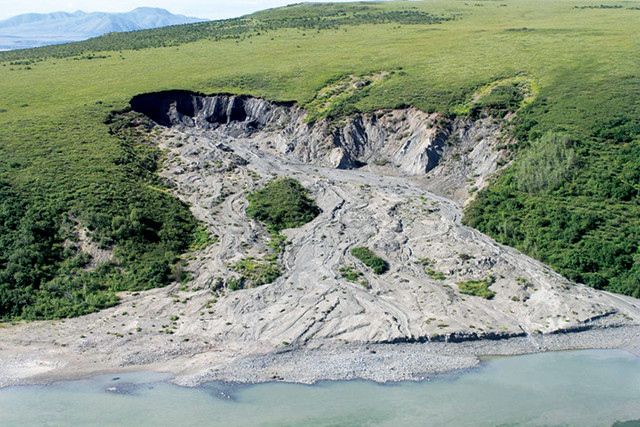
by Timothy Oleson Wednesday, April 13, 2016

Thawing permafrost in Alaska, which can lead to slope failures like this one along the Noatak River, may increase dramatically this century as air and ground temperatures rise. Credit: Rory Nichols.
From Antarctica to the Arctic; from polar caps, permafrost and glaciers to ocean-rafted sea ice; and from burly bears to cold-loving microbes, fascinating science is found in every nook and crevasse of Earth’s cryosphere, and new findings are announced often. Here are a few of the latest updates.
Measurements of ground temperatures collected since the 1980s at several sites, combined with modeling, suggest that much of the permafrost that pervades Alaska’s North Slope could thaw by the end of this century, according to researchers at the University of Alaska at Fairbanks (UAF) who presented their work at the fall meeting of the American Geophysical Union in San Francisco last December. At one location near Deadhorse, Alaska, for example, temperatures at the surface of the permafrost layer have increased from about minus 8 degrees Celsius in 1988 to about minus 3 degrees Celsius now, reported Vladimir Romanovsky, head of the Permafrost Laboratory at UAF. Climate modeling by the team suggested that, under current greenhouse gas emission rates, permafrost across more than half the North Slope could be thawing by 2100. Such thawing affects land stability, and, in turn, the safety of infrastructure like roads, buildings and pipelines, Romanovsky noted in a separate statement.
Melting of the massive West Antarctic Ice Sheet (WAIS) under the influence of a rapidly warming climate, as predicted by recent studies, could add meters to global sea levels. But according to new research in Nature Communications, this melting might be slowed by two negative feedbacks not typically considered in melt predictions: the decreasing gravitational pull of the shrinking ice sheet on the surrounding seawater, as well as the rebound — and rise in elevation — of Earth’s crust as the ice sheet’s weight is removed. (Glacial rebound in West Antarctica is expected to happen relatively quickly due to the anomalously warm and viscous mantle beneath the region.) Both factors cause the height of the sea surface lapping at the edges of the ice sheet — one of the main factors controlling how fast it melts — to drop, thus lessening its effect. Natalya Gomez of McGill University in Montreal, Canada, and colleagues modeled the future retreat of the ice sheet and found that, when they accounted for ice-sheet gravity and regional mantle structure, rates of WAIS ice loss and global sea-level rise slowed. The extent of the slowdown varied depending on the amount and pace at which future greenhouse emissions were introduced to the atmosphere. “The greater the emissions, the more the geophysical forces risk being overwhelmed by the strength of warming,” Gomez said in a statement. Still, she said, the study shows that predictive models for Antarctica “need to take into account how gravitational effects and variations in Earth structure could affect the pace of future ice-sheet loss.”
Researchers have found that the East Antarctic Ice Sheet (EAIS) has likely remained frozen in roughly its current state for at least 14 million years, suggesting it did not experience major melting several million years ago when global temperatures were just a few degrees Celsius warmer than today. Rachel Valletta of the University of Pennsylvania and colleagues collected shallow sediment samples from the Friis Hills, which poke out above the glacial ice amid East Antarctica’s Dry Valleys. The scientists noted in Scientific Reports that depletion of beryllium-10 in the sediments indicated they’d been frozen continuously for the last 14 million to 17.5 million years, when they were deposited in an ancient lake while the area was more moist tundra than frigid desert. Some researchers had hypothesized that the EAIS might have lost a third of its mass during the warm Pliocene, which lasted from about 5 million to 3 million years ago. But such warming and melting of the ice sheet would have enriched the sediments with more beryllium-10 than was found by Valletta’s team, suggesting that the occurrence of a large melting event is unlikely. “The Pliocene is sometimes thought to be an analog to what Earth will be like if global warming continues,” said co-author Jane Willenbring, also of the University of Pennsylvania, in a statement. The results offer “some hope that the East Antarctic Ice Sheet could be stable in today’s and future climate conditions,” she said, adding, however, that “we’ve probably never experienced [as] fast [a] transition to warm temperatures as we’re seeing right now.”
© 2008-2021. All rights reserved. Any copying, redistribution or retransmission of any of the contents of this service without the expressed written permission of the American Geosciences Institute is expressly prohibited. Click here for all copyright requests.